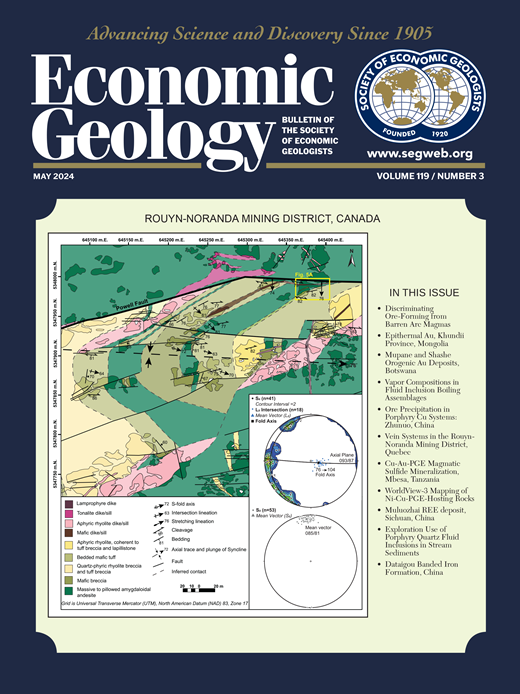The Hydrothermal Evolution of the Alvo Açaí Cu (Au, Mo) Skarn Deposit, Carajás Province, Brazil
IF 5.5
1区 地球科学
Q1 GEOCHEMISTRY & GEOPHYSICS
引用次数: 0
Abstract
The Alvo Açaí Cu (Au, Mo) skarn deposit forms part of several poorly explored copper deposits in the western sector of the Carajás province in Brazil. Here, a 2.86 Ga metasyenogranitic basement and a 2.71 Ga quartzite of the Liberdade Group are crosscut by diabase and granitic pegmatite dikes in the deposit area. The sequence of hydrothermal alteration at Alvo Açaí is marked by (1) early pervasive calcic-sodic alteration (hastingsitealbite) and (2) potassic iron alteration (biotite-almandine-grunerite) overprinted by (3) silicification (quartz), (4) prograde (grossular-hedenbergite), and (5) retrograde (actinolite-biotite-epidote) skarn stages. Late pervasive chloritization along with epidote-calcite veinlets crosscut the previous alteration zones. The main stage of copper mineralization (I) is spatially and temporally related to the retrograde skarn alteration for which three chalcopyrite-bearing mineral assemblages are distinguished on the basis of textural relationships and mineral associations: (1) actinolite-chalcopyrite-pyrrhotite-pyrite-magnetite-molybdenite, (2) biotite-chalcopyrite-pyrite-magnetite, and (3) epidote-pyrite-chalcopyrite-sphalerite. Minor chalcopyrite occurs along rare latestage epidote-calcite veinlets (mineralization II). The evolution of a single hot H2O-NaCl-CaCl2–dominated magmatic fluid of moderate salinity (22.8–28.6 wt % NaCl + CaCl2 equiv) toward a cooler H2O-NaCl fluid, with likely variable amounts of FeCl2, MgCl2, and KCl of low to moderate salinity (0.1–33.2 wt % NaCl equiv). Fluid evolution as a result of progressive crystallization of the granitic pegmatite was likely the trigger for mineralization I as supported by calculated δ18OH2O values from retrograde quartz. The chalcopyrite and pyrite δ34S values (–1.5, –1.1, and –0.7‰) point to a magmatic origin for the sulfur, which was most probably leached from surrounding igneous host rocks. The evolution of the Alvo Açaí deposit encompasses the development of the first copper skarn mineralization recognized in the Carajás province.巴西Carajás省Alvo Açaí Cu (Au, Mo)矽卡岩矿床热液演化
Alvo Açaí铜(Au, Mo)夕卡岩矿床是巴西Carajás省西部几个勘探不足的铜矿床的一部分。矿区内辉绿岩和花岗伟晶岩岩脉横切了2.86 Ga变长花岗岩基底和2.71 Ga Liberdade群石英岩。Alvo Açaí的热液蚀变序列表现为:(1)早期普遍的钙钠蚀变(黑石长石)和(2)钾化铁蚀变(黑云母-铝辉石-绿辉石)叠加(3)硅化(石英)、(4)顺行(粗硫-辉登辉石)和(5)逆行(放射石-黑云母-绿帘石)矽卡岩阶段。晚期普遍的绿泥化作用与绿帘石-方解石细脉横切了先前的蚀变带。铜成矿的主要阶段(I)在时空上与逆矽卡岩蚀变有关,根据构造关系和矿物组合可区分出3种含黄铜矿的矿物组合:(1)放线石-黄铜矿-磁黄铁矿-黄铁矿-辉钼矿,(2)黑云母-黄铜矿-黄铁矿-磁铁矿,(3)绿帘石-黄铁矿-黄铜矿-闪锌矿。少量黄铜矿沿罕见的晚期绿帘石-方解石脉(矿化II)发育。单一的中等盐度(22.8-28.6 wt % NaCl + CaCl2当量)的高温H2O-NaCl-CaCl2岩浆流体向较冷的H2O-NaCl流体演化,其中可能含有不同数量的低至中等盐度(0.1 - 33.2% NaCl当量)的FeCl2、MgCl2和KCl。花岗质伟晶岩的渐进结晶导致的流体演化可能是ⅰ型成矿的触发因素,这一点得到了逆行石英δ18OH2O值的计算结果的支持。黄铜矿和黄铁矿的δ34S值(-1.5‰、-1.1‰和-0.7‰)表明硫的岩浆成因,硫很可能是从周围火成岩中浸出的。Alvo Açaí矿床的演化包含了Carajás省发现的第一个铜矽卡岩矿化的发育。
本文章由计算机程序翻译,如有差异,请以英文原文为准。
求助全文
约1分钟内获得全文
求助全文
来源期刊

Economic Geology
地学-地球化学与地球物理
CiteScore
10.00
自引率
6.90%
发文量
120
审稿时长
6 months
期刊介绍:
The journal, now published semi-quarterly, was first published in 1905 by the Economic Geology Publishing Company (PUBCO), a not-for-profit company established for the purpose of publishing a periodical devoted to economic geology. On the founding of SEG in 1920, a cooperative arrangement between PUBCO and SEG made the journal the official organ of the Society, and PUBCO agreed to carry the Society''s name on the front cover under the heading "Bulletin of the Society of Economic Geologists". PUBCO and SEG continued to operate as cooperating but separate entities until 2001, when the Board of Directors of PUBCO and the Council of SEG, by unanimous consent, approved a formal agreement of merger. The former activities of the PUBCO Board of Directors are now carried out by a Publications Board, a new self-governing unit within SEG.
 求助内容:
求助内容: 应助结果提醒方式:
应助结果提醒方式:


